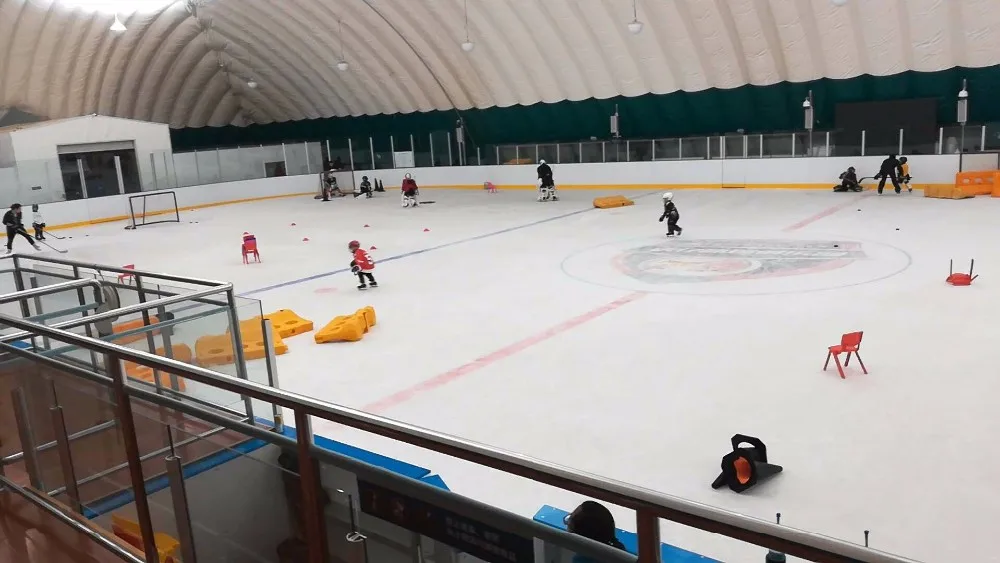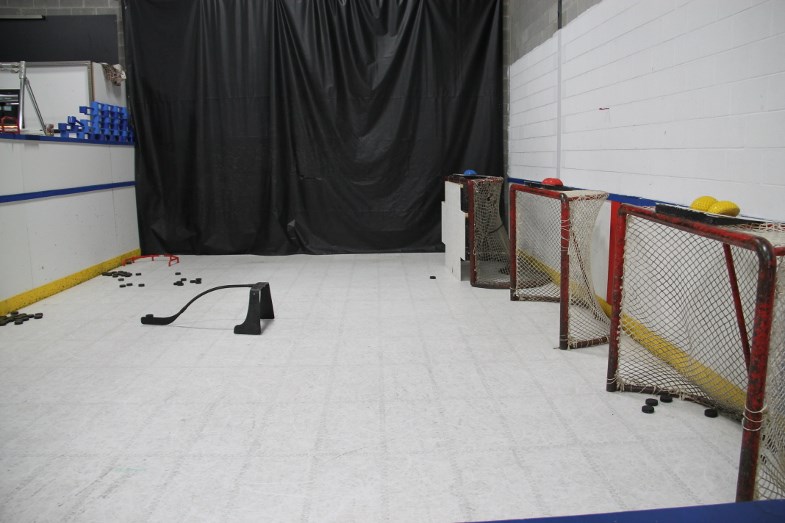It is hard to imagine how and why synthetic ice could become so popular and high in demand. Over the decades developers have increasingly improved the quality and the usability of this amazing ice-like flooring. It has been in the public eye since the early 1960s, and over the decades has become a staple for the practice of hockey players and ice skaters of all types. Why? Although there is not a simple cut and dry answer to this question, maybe the details of this article will shed some light on the topic, and give you an idea of why you should have a set up of synthetic ice in your own home.
What is Synthetic Ice, Anyway?
The word “synthetic” basically means “man made.” Of course, technically ice cubes could be considered synthetic ice because a person simply pours water into the ice trays, then puts them in the freezer to become ice. However, the synthetic ice we are talking about is not frozen, and is not so simple.
The first public introduction of artificial ice was back in the early 1960s. Back in those days plastics were still being explored and discovered. Polyoxymethylene plastic was the main ingredient for this kind of flooring. At first, artificial ice flooring was cumbersome and hard to work with. In fact, in order for the skates to be able to glide across the floor even a little similar to true ice there had to be a silicon-based lubricant added to the flooring. This lubricant had to be constantly applied in order to keep the flooring slick enough for people to skate on. Without the lubricant, ice skates would simply not move.
One of the many downfalls of this lubricant is that it was made out of silicon, which caused it to gum up and create a sticky surface where it would clump up and cause great difficulty for the people trying to skate upon it.
Every thirty minutes a person would have to scrape the excess gum from the flooring. Between the constant application of the lubricant and the excessive scraping that had to take place in order for the people to continue to ice skate the entire ice skating experience was not as pleasant as one would desire.
Polymer Plastics, Hockey Flooring, and Science
One of the reasons why the synthetic ice of the early 60s was so difficult to skate on is that it was made from inferior plastic materials. As time moved forward, the discoveries about plastics, polymers, and how to put them to good use evolved into a sophisticated solution that could almost mimic real ice.
Although synthetic ice is not as slick and graceful as true ice, it can get pretty close with the help of modern day polymer science. See, synthetic polymers are little molecular chains that can be manipulated by developers in a way that can ultimately change the entire structure of a substance just by having different molecules present.
For example, if on the molecular level an engineer develops a substance that can exude a lubricant based on the presence of heat or weight they can infuse that substance into polymer chains of the flooring and create a type of flooring that will self-lubricate as the skater glides across it.
Much like the human DNA, polymer chains can adapt and absorb instructions that will allow the object to behave in a way that it is developed to do. Artificial ice can be constructed at a molecular level and transformed into virtually whatever way that the developer has in mind. As the studies evolve and continue to provide more information, the quality of synthetic ice becomes more and more superior.
Real Ice and The Heat of Metal
It is not a secret that when ice is exposed to heat that it becomes water, or even steam. The way that ice works so great for people that skate upon it is that whenever a person glides across the surface on ice skates, the metal blades cause heat to occur. Although it is not enough heat to spark flames, or cause steam, it is enough to melt just a little bit of the ice along the path of the blades. Whenever the ice melts, it causes a thin layer of water to appear where the skates are gliding across. This tiny bit of water causes a slick, delightful pathway that is free from drag and pull.
As the skates move forward, the ice continues to melt at the front of the skates leaving a nice, slick route for the blades to flow right into. This is science in the most simple form.
Ice skaters on traditional ice have been able to achieve unbelievable works of art while moving across the flooring. Olympians have entranced the world with their exquisite figure skating again and again because the way that traditional ice allows them to freely flow across the surface without restraint.
Synthetic Ice Vs True Ice
In the grand scheme of things, man has been able to accomplish many extraordinary feats in the course of history. One of these feats has been the creation of high-quality synthetic ice flooring products. One of the most amazing things about synthetic flooring is that it can be broken down into compact panels that are easy to move around and install. If you want to build an ice skating rink in your own backyard, it is very possible to do so with synthetic ice panels.
True ice is not so easy to implement. First of all you will need a large enough space to install a cooling system strong enough to keep it frozen during hotter months. In order to keep ice frozen in a large space with temperatures over 80 degrees, it takes a lot of energy and a lot of money. If you live in an environment where the temperature remains constantly under the freezing point, which is 32 degrees fahrenheit, you could easily have an outdoor ice rink. If not, you should plan on spending a great deal of money and using a vast amount of resources to keep your rink running strong.
Although skating on real ice is seamless and graceful because of the natural way that it allows skaters to flow, synthetic ice is almost as graceful and adds an additional advantage to the people that skate on it.
There is a slight drag when a person skates across synthetic ice flooring. With high-quality synthetic ice panels a skater can be as close to the real deal as possible. However, there is a slight drag. This drag, however, is not enough to make it difficult to skate. The extra bit of force that a person has to exude in order to skate ends up building muscle and strength for the skater. It is because of this that people that practice on synthetic ice get better training than people that don’t. Pushing muscles makes them grow and makes them stronger. The real prize is when the skater finally makes it to a real ice rink and can feel the huge difference in strength, agility and dexterity.
Synthetic Ice May Be Better
If you take the differences between synthetic ice and real ice it is easy to see the advantages of using artificial ice than traditional ice. Artificial ice does not have to be frozen. It is portable, and easy to install. Another advantage of skating on this kind of flooring is that it builds strength and skills that are beyond just regular ice skating. Many ice skating champions over the years have taken advantage of being able to train on synthetic ice flooring, this could very well be the reason why this amazing flooring type has become so popular.





